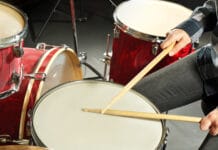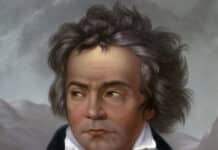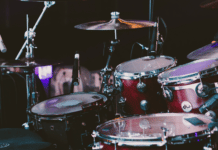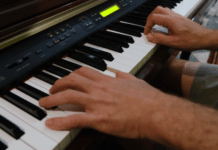Have you ever wondered what the best symphonies of all time are? We have, so we spent tens of hours listening various recordings of the best symphonies and have compiled a list of our top 10 best symphonies of all time below.
1. Brahms Symphony No. 4
Symphony No. 4 was Brahms’s last written symphony. It was premiered on October 25, 1885. Brahms himself played this beautiful symphony. This music is so powerful that it will continuously unfold you to different states of your mind. It’ll create conflict in your mind and soothe you at the next moment. A typical performance lasts for about 40 minutes.
This unique composition has four movements. They are:
- Allegro non-troppo
- Andante moderato
- Allegro giocoso
- Allegro energico e passionate
Instruments: two Flutes, two Oboes, two Trumpets, two Clarinets, two Bassoons, three Trombones, four Horns, Contrabassoon, Timpani, Triangle, and Strings.
2. Beethoven Symphony No. 5
This Beethoven symphony is one of the best-known symphonies of the classical era and the most frequently played one as well. It was premiered on 22 December 1808 and the Master himself conducted the performance. This is sometimes referred as a victory symphony. Most interestingly, the opening phrase of the symphony has been used as a Morse code.
This music is good enough to motivate you and bring out your spirit. And the melody will create peace in your mind no doubt. This powerful composition is consists of 4 movements:
- Allegro con brio
- Andante con moto
- Scherzo: Allegro
- Allegro
Instruments: 1 Piccolo, 2 Flutes, 2 Oboes, 2 Clarinets, 2 Bassoons, 1 Contrabassoon, 2 Horns, 2 Trumpets, 3 Trombones, Violins, Violas, Cellos, and Double Basses, Timpani.
3. Beethoven Symphony No. 3
This composition is one of the celebrated works of Beethoven. This symphony is considered to be one of the transition songs between classical era and romantic era. Combination of various instruments will create a climate in your mind and you’ll be lost in the rhythm and melody, no wonder!
This composition is used in films and it has been used in funerals since the 19th century. It has 4 movements. They are:
- Allegro con brio
- Marcia funebre: Adagio assai
- Scherzo: Allegro vivace
- Finale: Allegro Molto
Instruments: two Flutes, two Trumpets, two Clarinets, two Oboes, two Bassoons, three Horns, Timpani, and Strings.
4. Shostakovich Symphony No. 5
Shostakovich gained huge popularity with his Symphony no. 5. He wrote this piece in 1937. You’ll find grief and mourn in this composition. No wonder, it will capture your feelings for a moment.
A typical performance of this composition lasts for approximately 45 minutes and it has 4 movements as well.
- Moderato-Allegro non-troppo
- Allegretto
- Largo
- Allegro non-troppo
Instruments: two Flutes, two Oboes, two Clarinets, two Bassoons, two Harps, three Trumpets, three Trombones, four Horns, Tuba, Timpani, Snare Drum, Triangle, Cymbals, Bass Drum, Tam-tam, Contrabassoon, Glockenspiel, Xylophone, Piccolo, Piano, Celesta, and Strings.
5. Sibelius Symphony No. 7
This beautiful composition is Sibelius’s last complete symphony. Want to know the most interesting part of this composition? Well, it has only one movement! This work is considered to be Sibelius’s most remarkable achievement.
Instruments: The composition is scored for various instruments including 2 Flutes, 2 Oboes, 2 Clarinets, 2 Bassoons, 3 Trumpets, 3 Trombones, 4 Horns, Timpani, and Strings.
6. Mahler Symphony No. 5
Symphony no. 5 is Mahler’s most accepted work. It is a distinct composition in many determinations. Solo trumpet opening is one of them. Moreover, it has the same rhythmic motive that Beethoven used in his Symphony no. 5.
This superb composition will excite you with its emotional scope and musical canvas. A typical 70 minutes performance makes it a long but worthy one. It has five movements.
- Trauermarsch
- Stürmisch bewegt, mit größter Vehemenz
- Scherzo
- Adagietto
- Rondo finale
7. Mozart Symphony No 40
This composition is known as the ‘Great G Minor Symphony’ and one of the only two extant minor key symphonies that Mozart wrote. Beginning darkly it has anger, rhythm and what not! Mozart wrote this masterpiece in 1788.
The composition has 4 movements.
- Molto allegro
- Andante
- Menuetto: Allegretto- Trio
- Finale: Allegro assai
Instruments: 1 Flute, 2 Bassoons, 2 Clarinets, 2 Horns, 2 Oboes, and Strings.
8. Mendelssohn Symphony No. 4
This orchestral symphony by Mendelssohn is popularly known as the “Italian.” This multi-movement composition will bring joy to your mind for sure. Mendelssohn wrote it while his tour in Europe. This composition is influenced by the European culture.
This typically half an hour performance includes four movements:
- Allegro vivace
- Andante con moto
- Con moto moderato
- Presto and Finale: Saltarello
Instruments: 2 Flutes, 2 Bassoons, 2 Clarinets, 2 Horns, 2 Oboes, 2 Trumpets, Timpani, and Strings.
9. Tchaikovsky Symphony No 6
This symphony was the last completed symphony of Tchaikovsky. He named it as ‘The Passionate Symphony’. The music expresses passion and emotion. It has popularly been used in many films and songs. It has also been featured in 2010 Winter Olympics Closing Ceremony.
This beautiful composition is consists of 4 movements.
- Adagio – Allegro non troppo
- Allegro con grazia
- Allegro molto vivace
- Finale: Adagio lamentoso
Instruments: 3 Flutes, 2 Bassoons, 2 Clarinets, 2 Oboes, 4 Horns, 2 Trumpets, 3 Trombones, Tuba, Timpani, Bass Drum, Cymbals, Tam-tam and Strings.
10. Dvořák Symphony No 9
This symphony is popularly known as The New World Symphony. This is undoubtedly Dvorak’s best work and one of the all Symphonies. Want to know the best part of this symphony? It also landed on the moon along with Neil Armstrong and others. Isn’t it crazy? It has also been featured in many songs.
This marvelous composition has 4 movements.
- Adagio, 4
- Largo,
- Scherzo: Molto vivace — Poco sostenuto
- Allegro con fuoco
Instruments: 2 Flutes, 2 Oboes, 2 Clarinets, 2 Bassoons, 4 Horns, 2 Trumpets, 2 Tenor Trombones, Bass trombone, Tuba, Timpani, Triangle, Cymbals, and Strings.
Table of Contents






